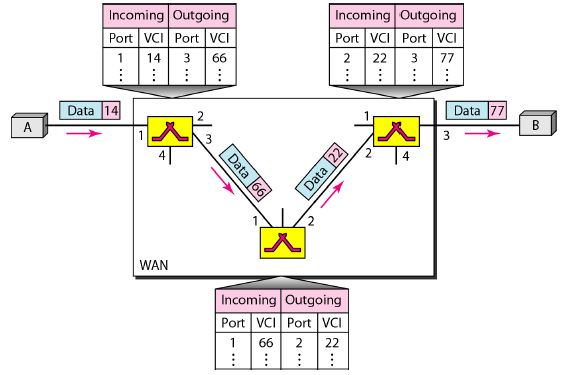VIRTUAL-CIRCUIT NETWORKS
A virtual-circuit network is a cross between a circuitswitched network and a datagram network. It has some characteristics of both.
Topics discussed in this section:
- Addressing
- Three Phases
- Efficiency
- Delay
- Circuit-Switched Technology in WANs
Virtual Circuit Switching
- As in a circuit-switched network, there are setup and teardown phases in addition to the data transfer phase.
- Resources can be allocated during the setup phase, as in a circuit switched network, or on demand, as in a datagram network.
- As in a datagram network, data are packetized and each packet carries an address in the header.However,the address in the header has local addresses.
- As in a circuit-switched network, all packets follow the same path established during the connection.
- A virtual-circuit network is normally implemented in the data link layer.
Virtual-circuit network
Addressing
In a virtual-circuit network, two types of addressing are involved: global and local.
Global Addressing: A source or a destination needs to have a global address-an address that can be unique in the scope of the network or internationally.
Local Addressing: The identifier that is actually used for data transfer is called the virtual-circuit identifier (VCI).A VCI, unlike a global address, is a small number that has only switch scope; it is used by a frame between two switches.
When a frame arrives at a switch, it has a VCI; when it leaves, it has a different VCl.
Virtual-circuit identifier
Switch and tables in a virtual-circuit network
Three Phase
As in a circuit-switched network, a source and destination need to go through three phases in a virtual-circuit network: setup, data transfer, and teardown.
In the setup phase, the source and destination use their global addresses to help switches make table entries for the connection.
In the teardown phase, the source and destination inform the switches to delete the corresponding entry.
Data transfer occurs between these two phases.
Setup request in a virtual-circuit network
Setup acknowledgment in a virtual-circuit network
Source-to-destination data transfer in a virtual-circuit network
Note
In virtual-circuit switching, all packets
belonging to the same source and
destination travel the same path;
but the packets may arrive at the
destination with different delays
if resource allocation is on demand.
Efficiency
- Source reservation in a virtual-circuit network can be made during the setup or can be on demand during the data transfer phase. In the first case, the delay for each packet is the same; in the second case, each packet may encounter different delays.
- There is one big advantage in a virtual-circuit network even if resource allocation is on demand. The source can check the availability of the resources, without actually reserving it.
Delay
In a virtual-circuit network, there is a one-time delay for setup and a one-time delay for teardown. If resources are allocated during the setup phase, there is no wait time for individual packets.
Delay in a virtual-circuit network
Note
Switching at the data link layer in a
switched WAN is normally
implemented by using
virtual-circuit techniques.






